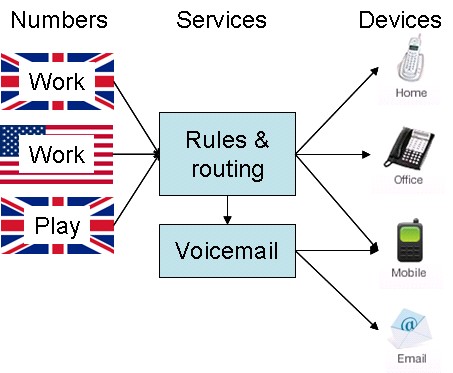Telepersona
This is one of those posts that I’ve been meaning to write for ages, and just not got around to it. I’d like to pull together some of the concepts that I’ve touched upon before such as persona, and the fact that telephone numbers are a primitive form of digital identity. Much of what I have to say got spat out already in comment’s on Sean Park’s post on Advanced economies, but it’s probably worth rounding things up.
The fact that we present different faces to the world is probably no more clear than with telephone numbers, and any contacts management system worth its salt will have fields for ‘work’ and ‘home’. ‘Mobile’ is perhaps more troubling though, as that’s the number that somebody literally carries around with them wherever they go. All sorts of customs have grown up over the years about which number is appropriate for a given circumstance, but these aren’t uniform – there can be huge differences between national cultures. Whilst I was actively going through a process of simplifying my business card down to one number I was learning that a typical card in Italy has around five! At the same time I hit resistance from people that thought I was holding out on them by withholding my mobile number, even though the number on my card routed to my mobile whenever I was away from my desk.
There are also distortions caused by telco pricing structures – calls to national numbers are typically free (meaning within some kind of bundle) whilst international calls might not be; mobile calls, and especially mobile calls to/from a different country can get scarily expensive.
There are a growing number of services now, like Google Voice, that facilitate the ‘one number’ paradigm – this is the number that you can reach me on wherever I am and whatever device I’m using. I think this works about as well as the idea that we should have one identity, one email address, one face to the world. It’s too simplistic, and therefore works badly. I don’t just want one number, I want many numbers – maybe a ‘personal’ number that I give out to friends (e.g. the people I connect to on FaceBook) and a ‘work’ number that I give out to colleagues and work contacts (e.g. the people I connect to on LinkedIn). I may even want to have a US ‘work’ number in addition to my native UK one so that I’m a bundled call away for those in the +1 country code (and I pick up the [least cost] routing charge). A simple block diagram for the overall offering might look like this:

Of course there are still issues – if I call somebody back then CLI will probably show the number for the device I’m using rather than the ‘in’ number that my contact might have in their address book. Will they know that it’s me calling and answer, or send an unknown number straight to voicemail? If they do pick up the call will they add the device number to my contact details, and route around my rules and routing in future. CLI can of course be manipulated, but it’s hard enough to do this right with one number harder still if there are multiple inbound numbers.
There are other complexities… SIP wants us to be an email address rather than a number, though of course we all have plenty of those already. Skype gives us another IM like identity, as does GoogleTalk. The receptionist that couldn’t cope with short dialling codes, ‘call me on *443 8805’, will probably have a brain haemorrhage if I say ‘call me on [email protected]’.
Just because this might be a bit tricky doesn’t mean that we shouldn’t push hard to get it sorted out. It would be nice if this was fixed before my kids become teenagers (and start hogging the phone all night).
Filed under: identity | 3 Comments
Tags: google talk, google voice, identity, mobile, persona, sip, skype, telco
I think your CLI issue could simply be solved by maintaining some concept of context in the model. It already works this way in most email clients that aggregate multiple accounts. If I reply to you, you see the email address used when you sent the original message to me. A smart router would use the client’s social network to do clever things within these contexts (e.g., automatically prioritise/flag calls based on closeness or type of relationship). Then all your emails / numbers become different aspects of your social personality, with the appropriate facet presented to the counterparty in any communication (work email, personal phone, family hotline, etc.)
The Sleepy Pedant
I am using Google Voice app on my iPhone and so people I call see my GV number and not my cell number. Unfortunately you can’t get GV app anymore. My expectation is that Android based phones will do this automatically.